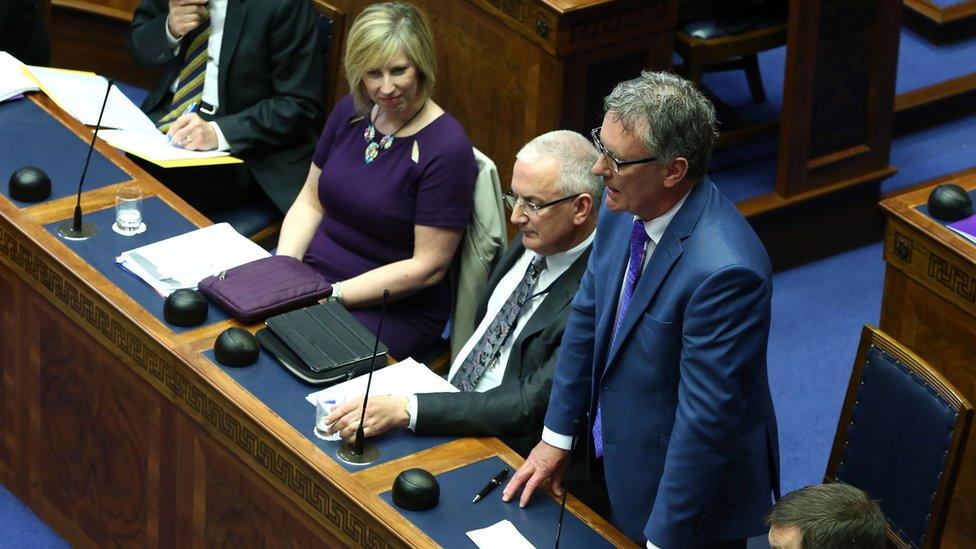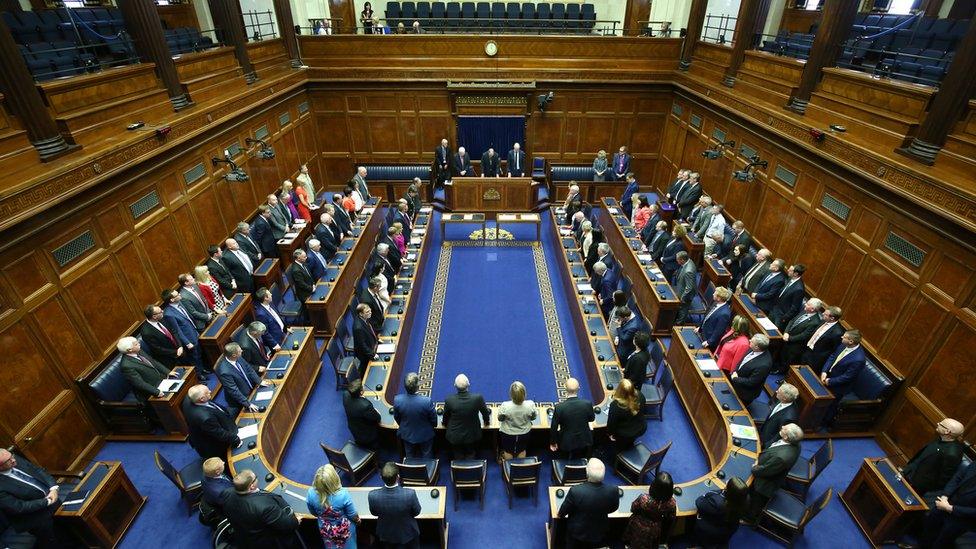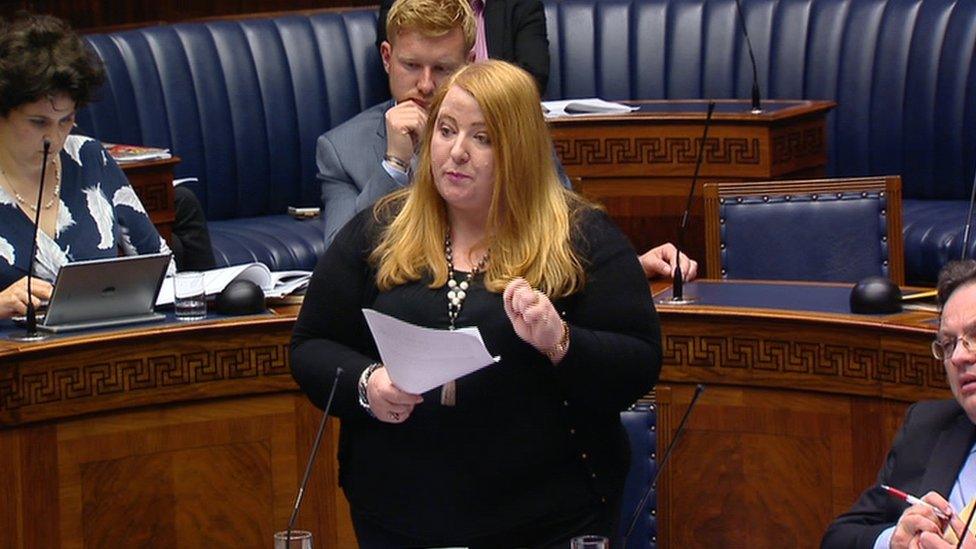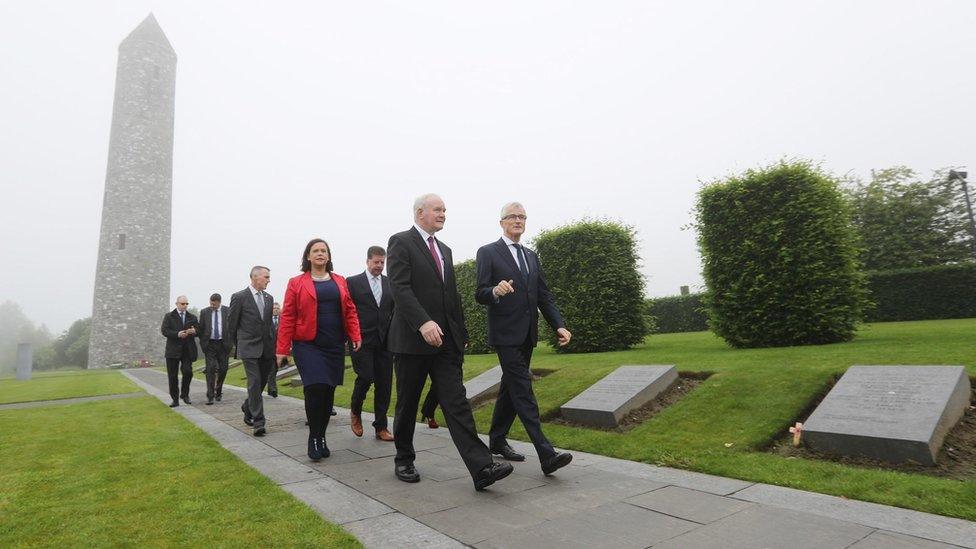How long will the Stormont honeymoon last?
- Published

Anyone thinking the new-look assembly will mimic Westminster practices is likely to be wrong
So, how long will the Northern Ireland Executive honeymoon last?
And what difference will the new Stormont opposition make in practice?
It is early days, but we now have a few initial indicators.
During the first formal debates in the Northern Ireland Assembly since the Democratic Unionist Party (DUP) and Sinn Féin-led executive was formed, we saw opposition MLAs called upon to respond directly to ministers.
First the Ulster Unionist Party's (UUP) Jo-Anne Dobson got the opportunity to put her points about hospital waiting lists immediately after Health Minister Michelle O'Neill set out her stall.

Mike Nesbitt says he wants to work with SDLP leader Colum Eastwood as 'co-equals' in opposition
Then UUP leader Mike Nesbitt was called to follow First Minister Arlene Foster.
Mrs Foster believes this is the start of a new era, promising that ministers will no longer work in "silos".
Instead, the nine new departments, she hopes, will work together to achieve common goals.
Mr Nesbitt, the leader of the opposition, said that, even at this early stage, the executive has failed to keep to the timetable for a programme for government set out in last year's Fresh Start Agreement.
He again derided the content of the executive's framework programme as vague "motherhood and apple pie".

Some new MLAs have proven they can make their points fluently and concisely in the chamber
Others as far apart as Traditional Unionist Voice (TUV) leader Jim Allister and People Before Profit Alliance (PBPA) MLA Gerry Carroll agreed with that assessment, with the latter describing the executive document as "114 pages of concentrated waffle".
But just as observers were beginning to get used to this government-opposition ding-dong, along came the Alliance Party's Naomi Long to prove the dynamics in the new assembly will be more complex.
She launched an assault, not on the government, but on the Ulster Unionists, suggesting they had been "delusional" to believe a full draft programme for government could ever have been negotiated in the two weeks after the assembly election.
Not surprisingly, Mr Nesbitt begged to differ.
Although the speaking rights and practices in the chamber are already reflecting the new dispensation, anyone who thinks Stormont will mimic Westminster is likely to be mistaken.

Naomi Long aimed a jab at the Ulster Unionists in the new assembly term's early exchanges
Mr Nesbitt said on Sunday that he wants to work together with Social Democratic and Labour Party (SDLP) leader Colum Eastwood as "co-equals" in opposition.
But that does not mean their two parties will coalesce into a single opposition.
One can imagine that, on certain issues, the UUP and SDLP will be able to share a common platform.
But there are many others, such as parading, the legacy of Northern Ireland's Troubles, or even the relocation of public sector jobs, where their parties will pull in different directions.
Mr Eastwood has already said that he's "no-one's deputy".

Colum Eastwood says he will be "no-one's deputy" in opposition at Stormont
With the Green Party, PBPA and the TUV all coming at the executive from their own distinct angles, the voices of opposition will make themselves heard, but they will not always sing off the same hymn sheet.
In comparison, the DUP and Sinn Féin have sought to portray a cohesive image.
Martin McGuinness's trip to the Somme, Peter Weir's visit to an Irish language school and the consensus over Mrs O'Neill's decision to lift the ban on blood donations from gay men constitute a reasonable start.
So, will a cohesive government run rings around a divided opposition?
Maybe, but all governments, power sharing or not, are vulnerable to the passage of events.

Martin McGuinness's visit to Flanders and the Somme was an attempt to reach out to unionists
Already we have had a row over council funding for a community centre in the Glens of Antrim, and a difference of opinion over Finance Minister Máirtín Ó Muilleoir thinking out loud about extra borrowing and fiscal powers.
No doubt there will be much more to come.
Perhaps the latest batch of Stormont ministers will climb out of their silos.
But those with long memories may recall that, back in 2011, the DUP manifesto promised to "seek to break down the silo mentality in government departments through incentivising cross-departmental collaboration".
How did that work out?
Whatever happens, it was heartening that on day one a number of our new MLAs proved they can make their points fluently and concisely.
On that score, at least, let's hope the assembly continues just as it began.